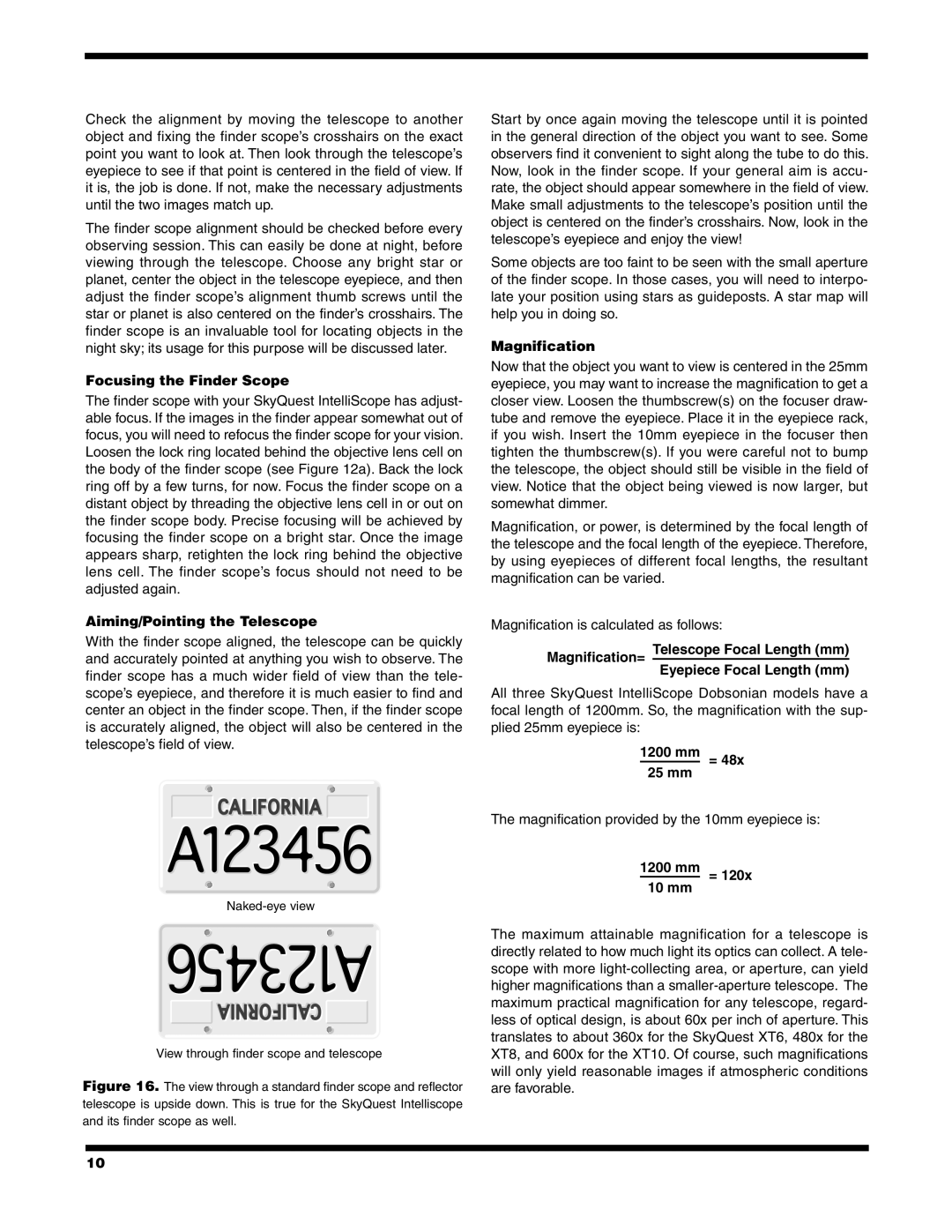
Check the alignment by moving the telescope to another object and fixing the finder scope’s crosshairs on the exact point you want to look at. Then look through the telescope’s eyepiece to see if that point is centered in the field of view. If it is, the job is done. If not, make the necessary adjustments until the two images match up.
The finder scope alignment should be checked before every observing session. This can easily be done at night, before viewing through the telescope. Choose any bright star or planet, center the object in the telescope eyepiece, and then adjust the finder scope’s alignment thumb screws until the star or planet is also centered on the finder’s crosshairs. The finder scope is an invaluable tool for locating objects in the night sky; its usage for this purpose will be discussed later.
Focusing the Finder Scope
The finder scope with your SkyQuest IntelliScope has adjust- able focus. If the images in the finder appear somewhat out of focus, you will need to refocus the finder scope for your vision. Loosen the lock ring located behind the objective lens cell on the body of the finder scope (see Figure 12a). Back the lock ring off by a few turns, for now. Focus the finder scope on a distant object by threading the objective lens cell in or out on the finder scope body. Precise focusing will be achieved by focusing the finder scope on a bright star. Once the image appears sharp, retighten the lock ring behind the objective lens cell. The finder scope’s focus should not need to be adjusted again.
Aiming/Pointing the Telescope
With the finder scope aligned, the telescope can be quickly and accurately pointed at anything you wish to observe. The finder scope has a much wider field of view than the tele- scope’s eyepiece, and therefore it is much easier to find and center an object in the finder scope. Then, if the finder scope is accurately aligned, the object will also be centered in the telescope’s field of view.
View through finder scope and telescope
Figure 16. The view through a standard finder scope and reflector telescope is upside down. This is true for the SkyQuest Intelliscope and its finder scope as well.
Start by once again moving the telescope until it is pointed in the general direction of the object you want to see. Some observers find it convenient to sight along the tube to do this. Now, look in the finder scope. If your general aim is accu- rate, the object should appear somewhere in the field of view. Make small adjustments to the telescope’s position until the object is centered on the finder’s crosshairs. Now, look in the telescope’s eyepiece and enjoy the view!
Some objects are too faint to be seen with the small aperture of the finder scope. In those cases, you will need to interpo- late your position using stars as guideposts. A star map will help you in doing so.
Magnification
Now that the object you want to view is centered in the 25mm eyepiece, you may want to increase the magnification to get a closer view. Loosen the thumbscrew(s) on the focuser draw- tube and remove the eyepiece. Place it in the eyepiece rack, if you wish. Insert the 10mm eyepiece in the focuser then tighten the thumbscrew(s). If you were careful not to bump the telescope, the object should still be visible in the field of view. Notice that the object being viewed is now larger, but somewhat dimmer.
Magnification, or power, is determined by the focal length of the telescope and the focal length of the eyepiece. Therefore, by using eyepieces of different focal lengths, the resultant magnification can be varied.
Magnification is calculated as follows:
Magnification= Telescope Focal Length (mm)
Eyepiece Focal Length (mm)
All three SkyQuest IntelliScope Dobsonian models have a focal length of 1200mm. So, the magnification with the sup- plied 25mm eyepiece is:
1200 mm = 48x
25 mm
The magnification provided by the 10mm eyepiece is:
1200 mm = 120x
10 mm
The maximum attainable magnification for a telescope is directly related to how much light its optics can collect. A tele- scope with more
10
